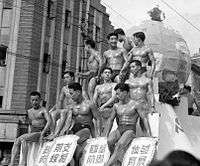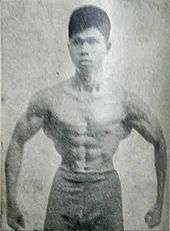Bodybuilding in China
Bodybuilding in China dates back to the 1930s. It was first introduced to the Chinese in Guangzhou, when missionary school attendee Zhao Zhuguang started promoting it, having attended overseas bodybuilding courses. However, its early history was marred with controversy, and the Communist Party of China, led by Chairman Mao Zedong, publicly condemned the sport and officially banned it in 1953. The ban was only abolished close to three decades later; thereafter, bodybuilding contests for men started to be organised, and China became a member of the International Bodybuilding Federation in 1985. Competitions for women were held soon afterwards. China now has a national federation governing bodybuilding in the country, the Chinese Bodybuilding Association.[source?]
| Bodybuilding in China | |
|---|---|
 Shanghainese bodybuilders in the 1950s | |
| Governing body | Chinese Bodybuilding Association (中国健美协会) |
| First played | 1930s |
History
1930s−1950s: Genesis and later ban by government

Bodybuilding was first practiced in China in the 1930s; Zhao Zhuguang (赵竹光), described as the "original Chinese Charles Atlas", is credited with the introduction of bodybuilding to the country.[1] Zhao studied at a missionary school in Shanghai and later went to the United States, where he attended seminars and workshops on bodybuilding to help boost his health and physique.[1] He shared the newfound knowledge with his fellow schoolmates, and together they started promoting the sport at the Huijiang University in Guangzhou.[1] In 1934, Zhao Zhuguang authored a book on bodybuilding, titled Muscle Growth Methods (肌肉发达法).[2]
Beijing-based Lin Zhuyin became acquainted with Zhao in the 1940s; he turned into a bodybuilding enthusiast and opened a gym at the local Young Men's Christian Association building.[1] However, there and in other parts of China, bodybuilding only took off with affluent young males whereas many others who were aware of bodybuilding could not afford to practise it for economical, practical, or physical reasons.[1] Nevertheless, it was also well received by the lower classes of Chinese society, namely farmers and blue-collar workers. In 1953, Lin Zhuyin posed for Chinese officials who went on to pan it as a "bourgeois"[1] practice and an "unproductive and narcissistic pursuit of beauty originating in the capitalist West".[3] Furthermore, there was little pragmatic incentive in investing in bodybuilding because it was not a competitive segment in the Olympic Games.[3] The Mao Zedong-led Chinese Communist Party banned bodybuilding that year.[1]
1980s: A new era
The ban was in effect for 30 years, until it was officially lifted in 1983.[3] While the ban was still in place, however, many secretly practised bodybuilding under the "father of Chinese bodybuilding", Luo Zhuoyu (娄琢玉), who corresponded with American bodybuilding promoter Joe Weider and the Chinese Weightlifting Federation.[4] The "most influential bodybuilding circular in China", Bodybuilding and Beauty (健与美), and the Chinese Bodybuilding Association staged the first national bodybuilding contest, the Hercules Cup.[5][4]
The "first privately owned health club and bodybuilding gym" was established by Guangdong local Yuan Guohui in 1985, who went on to organise his own bodybuilding events. In the same year, China became the 128th[4] member of the global bodybuilding organization, the International Bodybuilding Federation.[4] Female participants were allowed to register for the first time, albeit with the stipulation of only being able to pose in bathing suits. Whether women should be allowed to compete in bikinis was a matter of excited discussion,[6] leading to a "bikini controversy". International standards held that women were to wear them.[7] The 1986 Hercules Cup in Shenzhen was the first tournament in China to feature bikini-wearing competitors.[8] The 1980s also saw a surge in the number of fitness schools and sportswear stores in China.[9]
1990s−present: Advancements
China joined the International Federation of Bodybuilding and Fitness (IFBB) in 1990.[10] By-and-by, it has become an active player in the global bodybuilding scene. For instance, the 59th IFBB World Amateur Bodybuilding Championships for men, and the accompanying international bodybuilding summit and expo, was hosted in Shanghai in November 2005.[11]
Governance
Bodybuilding in China is governed on the national level by the Chinese Bodybuilding Association (中国健美协会),[11] often abbreviated as the Chinese Fitness Committee (中国健协). The association was founded on 8 September 1992.[12] Shanghai, considered the bodybuilding hub of China,[1] is under the jurisdiction of the Shanghai Bodybuilding Association.[11]
See also
- Sport in China


References
Citations
- Brownell 1995, p. 267.
- Zhao 2015, p. 14.
- Brownell 1995, p. 268.
- Steere, Weider, and Weider 2006, p. 262.
- Sports literature and history 1994, p. 21.
- Wu 1994, p. 128.
- Schell 2010, p. 56.
- Schell 1995, p. 1986.
- Chinese Youth 1987, p. 31.
- Schwarzenegger 2012, p. 116.
- Roach 2011, p. 171.
- Huang 2004, p. 235.
Bibliography
- Brownell, Susan (1995). Training the Body for China: Sports in the Moral Order of the People's Republic. University of Chicago Press. ISBN 978-0-226-07647-8.
- Chinese Youth. 7. International Department of the All-China Youth Federation. 1987.
- Huang, Yaling (2004). 论中国体育社团: 国家与社会关系转变下的体育社团改革 [On the sports circle in China] (in Chinese). University of Physical Education Beijing Press. ISBN 978-7-81100-232-4.
- Roach, Randy (2011). Muscle, Smoke and Mirrors. AuthorHouse. ISBN 978-1-4670-3840-9.
- Schwarzenegger, Arnold (2012). The New Encyclopedia of Modern Bodybuilding: The Bible of Bodybuilding, Fully Updated and Revis. Simon and Schuster. ISBN 978-1-4516-9713-1.
- Schell, Orville (1995). Mandate of Heaven: The Legacy of Tiananmen Square and the Next Generation of China's Leaders. Simon and Schuster. ISBN 978-0-684-80447-7.
- Schell, Orville (2010). Discos and Democracy: China in the Throes of Reform. Knopf Doubleday Publishing Group. ISBN 978-0-307-76714-1.
- 体育文史 [Sports literature and history] (in Chinese). Sports literature and history. 1994.
- Steere, Mike; Weider, Ben; Weider, Joe (2006). Brothers of Iron. Sports Publishing LLC. ISBN 978-1-59670-124-3.
- Wu, Dingbo (1994). Handbook of Chinese Popular Culture. Greenwood Publishing Group. ISBN 978-0-313-27808-2.
- Zhao, Jian (2015). 健身教練118種技巧肌力訓練法 [118 kinds of strength training methods]. Human Intelligence. ISBN 978-986-373-142-9.